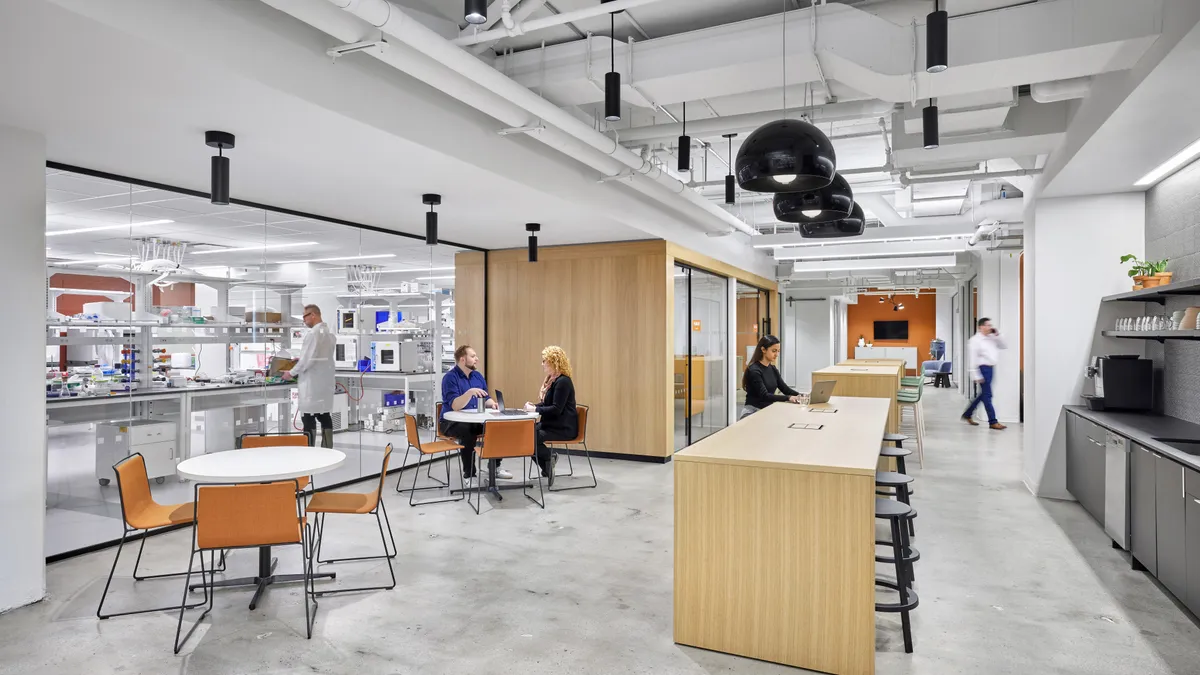A recent lab project in New York City showcases the importance of collaboration between contractors and architects.
Early on, New York City-based Talisen Construction worked with architect Perkins + Will on the creation of a wet lab space on the 7th floor of the Hudson Research Center project in Manhattan developed by Elevate Research Properties, the life sciences subsidiary of Taconic Partners. This early involvement enabled the team to identify cost and time savings opportunities, particularly through value engineering, according to Michael Figliolia, Talisen director of construction.

“By defining roles and responsibilities early on and practicing active listening, we effectively addressed concerns and made informed decisions,” Figliolia told Construction Dive. “Documenting decisions and promptly addressing issues further ensured that the project proceeded smoothly.”
Talisen is now working with Perkins + Will on a follow-up project in the same building, to be completed later this year.
Here, Figliolia talks with Construction Dive about the importance of collaboration and tech solutions for keeping team members on the same page.
Editor’s note: This interview has been edited for brevity and clarity.
CONSTRUCTION DIVE: Tell us about the Hudson Research Center project that you completed with Perkins + Will.
MICHAEL FIGLIOLIA: The 7th-floor wet lab pre-built laboratory project, which built on our previous projects at this location, heavily relied on technology such as BIM to optimize the project in the early stages.
Early on, the digital modeling functionality identified opportunities for cost and time savings by identifying potential rework scenarios that would have been difficult to pinpoint without these tools.
For instance, project players leveraged 3D scanning to create BIM models for the plumbing and HVAC portions of the project. This comprehensive surveying and modeling process fostered collaboration within the design team and guaranteed accurate placement of building systems.
Team members maintained clear and consistent communication via Procore software and regular meetings and updates helped them stay on track. Our Bid|Buy|Build model provided a single point of contact, simplifying communication and decision-making.
In addition to technology, what are some other ways that you foster a relationship with architects?
There are several essential components to fostering a strong architect-contractor relationship. The first is early collaboration. Contractors should be engaged early in the design process to align objectives and identify potential issues before they become problems.
This form of value engineering helps set realistic expectations for the client while allowing the contractor to discover areas where costs can be cut without surrendering quality. It also helps prevent schedule disruptions that could have been easily prevented.
Then you need to define roles. Clearly outline the roles and responsibilities of each team member to avoid misunderstandings and ensure accountability.
Active listening is also critical. Both parties should practice active listening to understand each other's perspectives and address concerns promptly.
Other important aspects to remember are providing consistent, regular updates, documenting decisions and addressing any problems that arise promptly so they don’t escalate.
You mentioned your Bid|Buy|Build approach. How does that work?
Construction projects are often marred by information gaps that adversely impact schedules and budgets, leading to significant cost overruns. Talisen has eliminated the barriers between estimating departments, procurement teams and construction offices to prevent the knowledge loss typically experienced during inefficient team hand-offs.
Our Bid|Buy|Build approach ensures a superior product, with a dedicated project manager serving as the client’s sole point of contact throughout the project — an information hub and single point of accountability from initial budgeting to project closeout.
What challenges are you seeing in your markets right now?
We're seeing several challenges in our markets right now, including supply chain disruptions, fluctuating material costs and labor shortages. These issues can lead to project delays and increased costs for the contractor.
Additionally, navigating evolving building codes and regulations, especially in the healthcare and life sciences sectors, adds complexity to project planning and execution.













